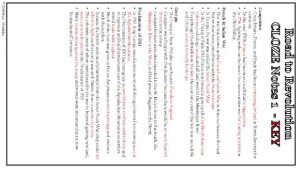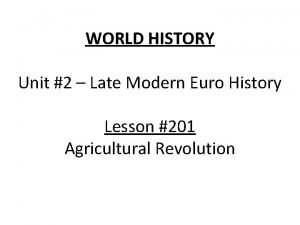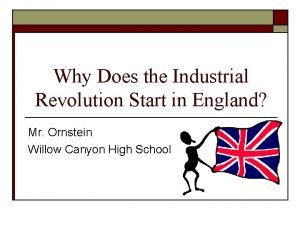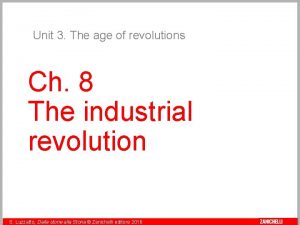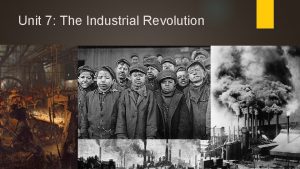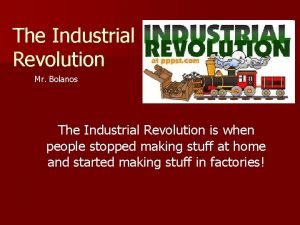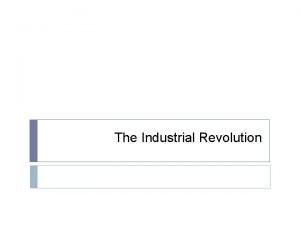Unit 7 Notes 5 THE INDUSTRIAL REVOLUTION INDUSTRIAL









- Slides: 9


Unit 7, Notes 5 THE INDUSTRIAL REVOLUTION

INDUSTRIAL REVOLUTION 101 Industrial Revolution: transformation of western society during the 19 th century in which a traditional, labor-intensive economy based on farming and handicrafts became a capital-intensive economy based on manufacturing by machines, specialized labor, and industrial factories � Began in England where it made Great Britain the wealthiest nation in the world and exported to the U. S. � Industrialization requires � � � � Capital (money to get started) Cheap labor Power source Raw materials Transportation Large consumer population

CAUSES OF THE INDUSTRIAL REVOLUTION: CAPITALISM AND DEMOGRAPHICS � American economic system of free enterprise (capitalism) promotes industrialization � � Allows people to acquire capital and make their own economic decisions Promotes competition that encourages better industrial practices Allows companies to become corporations (sell company stocks to raise more money and limit liability) Cheap labor � American population centers (Northern cities) and increased immigration provided a cheap workforce

CAUSES OF THE INDUSTRIAL REVOLUTION: NEW POWER SOURCES � Water power and steam engines � � � British textile worker, Samuel Slater, moved to Rhode Island developed first American water frame textile mill Francis Lowell opened a series of mills and introduced the mass production of textiles James Watt invented a rotary engine powered by steam with the ability to turn a shaft and drive machinery Productivity increased as new machinery was developed Factories no longer dependent on human/animal power

CAUSES OF THE INDUSTRIAL REVOLUTION: TRANSPORTATION REVOLUTION � Transportation revolution � � � Construction of the Erie Canal: manmade water route that connected the Hudson River to Lake Erie (helped NYC to prosper) Robert Fulton developed the first steamboat (Clermont) Peter Cooper built the first locomotive or "iron horse" (Tom Thumb) Railroad industry provided jobs, promoted growth in coal and iron industries (coal production… 1820: 50, 000 tons, 1860: 14 million tons) and allowed businesses to ship their products cheaper and faster Cheaper shipping = cheaper products = increased markets (more consumers can afford products) = increased sales = increase in the amount of factories and machinery needed to meet the new sale demands (more jobs)

CAUSES OF THE INDUSTRIAL REVOLUTION: TECHNOLOGY AND COMMUNICATION � Interchangeable parts � � � Interchangeable parts: identical parts or components used to develop or repair a finished product Developed by Eli Whitney when he created gun-making factories Allowed manufacturers to mass produce and assemble products Provided the ability to easily repair/replace products Generated a swifter rate of production Communication revolution � � Telegraph constructed by Samuel Morse in 1838 First long distance telegraph connected Washington, D. C. to Baltimore, Maryland in 1844 Allowed information to travel quickly over vast areas Allowed industries to operate more efficiently and breaking news to spread quickly

MAJOR INDUSTRIES OF THE INDUSTRIAL REVOLUTION Textile industry � Coal industry � Iron industry � Railroad industry � Shipping industry � Rifle industry �

INDUSTRIALIZATION AND THE AMERICAN CITIES � � � Industrialization led to the growth of American cities In 1820, only one American city had over 100, 000 residents…by 1860 8 cities had over 100, 000 residents Cities promoted growth of other American jobs: � � � � Publishers/writers (75% literacy rate by 1840) Police officers Firemen Utility workers Govt. officials Public transportation workers Shopkeepers
 Russian revolution vs french revolution
Russian revolution vs french revolution You should hope that this game will be over soon
You should hope that this game will be over soon Definition of third agricultural revolution
Definition of third agricultural revolution Road to revolution cloze notes 1
Road to revolution cloze notes 1 Colonial georgia cloze notes
Colonial georgia cloze notes Russian revolution guided notes
Russian revolution guided notes Unit 10, unit 10 review tests, unit 10 general test
Unit 10, unit 10 review tests, unit 10 general test Enclosure movement industrial revolution
Enclosure movement industrial revolution Why did the industrial revolution start in britain
Why did the industrial revolution start in britain Zanichelli
Zanichelli




